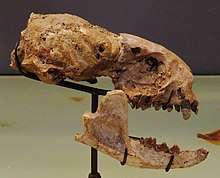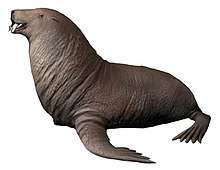Potamotherium
Potamotherium ('river beast') an extinct genus of caniform carnivoran from the Miocene epoch of France and Germany. It has been previously assigned to the mustelid family, but recent work suggests that it represents a primitive relative of pinnipeds.
| Potamotherium | |
|---|---|
 | |
| P. valletoni skeleton | |
| Scientific classification | |
| Kingdom: | Animalia |
| Phylum: | Chordata |
| Class: | Mammalia |
| Order: | Carnivora |
| Family: | †Semantoridae |
| Genus: | †Potamotherium Geoffroy, 1833 |
| Species | |
| |
Classification

The genus was first described in 1833. Carroll (1988) assigned it to the family Mustelidae as a member of the subfamily Oligobuninae. However, it was recently suggested that Potamotherium was not a mustelid at all, but rather a very basal pinniped.[1][2] Berta et al. (2018) placed Potamotherium along with Puijila and Semantor in the family Semantoridae.[3]
Two species have been identified in the genus: P. valletoni, the type species, and P. miocenicum.[4]
Distribution

Finds range from the mid-latitudes of Europe and North America, dated from the Oligocene/Miocene boundary and surviving through to the end of the Miocene.[5][6] It has been interpreted by several researchers as a basal, non-marine ancestor of seals and sea lions, suggesting a freshwater phase in the evolutionary transition of pinnipeds from land to sea. If Potamotherium was indeed a pinniped instead of a mustelid, its relatives were possibly early bears (whose ancestors at the time were small and generally weasel-like).[2]
Palaeology
Physically, Potamotherium resembled a modern otter, and was 1.5 metres (5 ft) long, with an elongated, slender body and short legs. With a flexible backbone and a streamlined shape, it was probably a good swimmer. Analysis of fossils suggests that Potamotherium had a poor sense of smell, but made up for this with good vision and hearing.[7]
References
- Ed Yong (2009-04-22). "Puijila, the walking seal – a beautiful transitional fossil". Not Exactly Rocket Science. Discover Magazine. Archived from the original on 3 November 2012. Retrieved 2014-10-07.
- Natalia Rybczynski; Mary R. Dawson; Richard H. Tedford (2009). "A semi-aquatic Arctic mammalian carnivore from the Miocene epoch and origin of Pinnipedia". Nature. 458 (7241): 1021–1024. Bibcode:2009Natur.458.1021R. doi:10.1038/nature07985. PMID 19396145.
- Berta, A., Churchill, M., & Boessenecker, R.W. (2018). "The Origin and Evolutionary Biology of Pinnipeds: Seals, Sea Lions, and Walruses". Annual Review of Earth and Planetary Sciences. 0. doi:10.1146/annurev-earth-082517-010009.
- "Potamotherium at the Paleobiology Database". paleodb.org. Retrieved 2008-11-25.
- Tedford, R. H. et al. (2004): Late Cretaceous and Cenozoic Mammals of North America (ed. Woodburne, M. O.), pp 169–231 (Columbia Univ. Press, 2004)
- Mörs, T. & Von Koenigswald, W. (2000): Potamotherium valletoni (Carnivora, Mammalia) aus dem Oberoligozän von Enspel im Westerwald. Senckenberg. Leth. no 80: pp 257–273
- Palmer, D., ed. (1999). The Marshall Illustrated Encyclopedia of Dinosaurs and Prehistoric Animals. London: Marshall Editions. p. 215. ISBN 1-84028-152-9.

